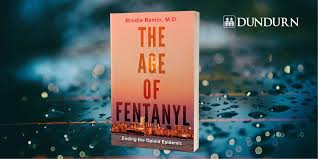Review of The Age of Fentanyl
Dundurn Press. 2020. 232 pages.
“In the hallway that leads to the drop-in area of our clinic, there is an overdose memorial wall filled with names and photos,” Dr. Brodie Ramin notes. He’s a medical practitioner in Ottawa that got his start in Toronto, helping the worst addicts get better since before he had his M.D. He began his career at the start of the current opioid crisis. Not the first one, just the newest version. This one has brought about a deadly agent that kills with the smallest dosage: fentanyl. “Sometimes people write messages of farewell next to the faces.”
Dr. Ramin’s new nonfiction book, The Age of Fentanyl, tells the story of the North American opioid crisis through personal accounts and research. He speaks about his patients from the various clinics he’s worked in. More than that, he traces the origins of heroin, oxy, and drugs like them throughout history. He provides information on the divine poppies of Greece, the mass marketing of 19th-century painkillers, the emergence of heroin and morphine, and finally, the creation and mass production of fentanyl. Dr. Ramin provides information on prevention: like naloxone which is used to reverse overdoses: on people fighting Big Pharma, like Marcia Angell who wrote a tell-all against the pharmaceutical industry: and on new treatments, such as buprenorphine which is replacing methadone as a way to wean people off heroin and other opioids. With this information comes influential terms and ideas such as a fentanyl lollipop, “death by rehab” (which is an overdose after one’s tolerance is reduced by rehab), and the fact that “one in six people” experience substance abuse in their lifetime. All of it harkens toward a deadly future and an era that redefines how people treat addiction. And in turn, addicts.
What The Age of Fentanyl so perfectly captures is the reality of this epidemic. Fentanyl entered the drug market and left a mark. Heroin became a carrier pigeon that presented its message well; this drug will consume you. Addicts learned that “there was a kind of fentanyl you could not come back from.” Dr. Ramin even notes that he had to continue working in addiction centres because, as he puts it, “the epidemic called my name.” In this book, he tries to do the same. Each chapter is aimed not only to inform but as a call to action. Most people stigmatize opioids so much that they become oblivious to the reality of addiction. Dr. Ramin strips away the curtain and points forward. In many cases, his writing is illuminating. The epidemic is so pervasive that the individuals responsible for it are mainly doctors and dentists. Imagine going for a root canal, and the next month you’re haggling a dealer for pills. This happened to a patient of Dr. Ramin, who was a banker before she became an addict.
There’s a reason I started this review with a memorial. During my time in the Ottawa Hospital psych ward, I met someone who gave me a lot of advice. He had been in-and-out since he was eighteen, and had multiple returns to rehab. I was struggling with addiction in addition to my mental health. It wasn’t heroin, but I was dependent. My friend taught me many things about getting better and staying healthy. Not that this helped, but he smuggled cigarettes so I could smoke in the bathroom. I still return to most of his advice. Once I was released from the hospital, another person from the ward texted me. The text said my friend had overdosed the other night. That he listed me as an emergency contact, but they didn’t have a number. That the nurses found fentanyl in his blood. They told me later that it was a “death by rehab.”
My review won’t bring him back. Neither will Dr. Ramin’s book. But both of us are aiming to break down the stigma with a shot of reality. We want people to become aware, and to understand that addiction comes for everyone. Not every addict wants to stay one, and most understand their way of life isn’t sustainable. Everyone needs help. That’s why doctors are there, but people can do it too. Dr. Ramin presents options such as promoting viable treatment options, providing safe environments, and being there for people. He believes this epidemic can get a naloxone injection, and provides ten steps to do it. I think it takes more than that, though I’m not a doctor. We both know, however, that though you may fight, “the opioid fights back.”

